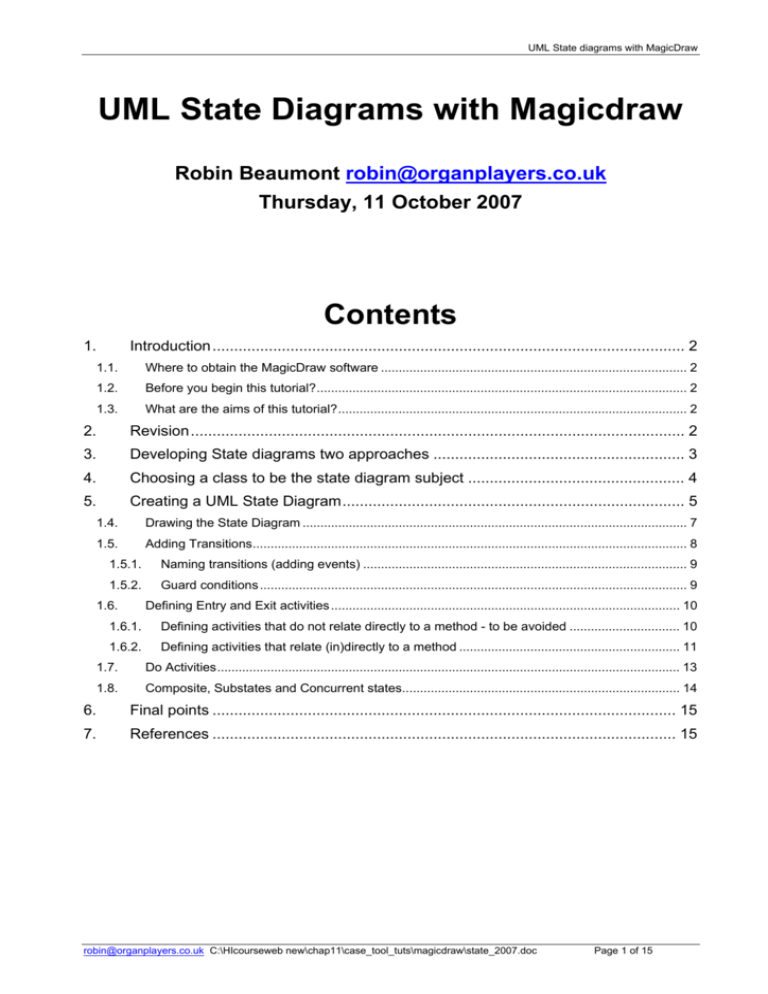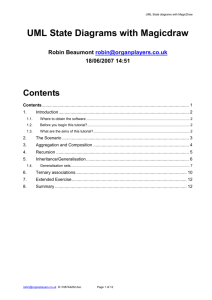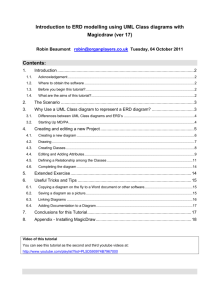Starting the UML Tutorial
advertisement

UML State diagrams with MagicDraw UML State Diagrams with Magicdraw Robin Beaumont robin@organplayers.co.uk Thursday, 11 October 2007 Contents 1. Introduction............................................................................................................. 2 1.1. Where to obtain the MagicDraw software ...................................................................................... 2 1.2. Before you begin this tutorial?........................................................................................................ 2 1.3. What are the aims of this tutorial?.................................................................................................. 2 2. Revision.................................................................................................................. 2 3. Developing State diagrams two approaches .......................................................... 3 4. Choosing a class to be the state diagram subject .................................................. 4 5. Creating a UML State Diagram............................................................................... 5 1.4. Drawing the State Diagram ............................................................................................................ 7 1.5. Adding Transitions.......................................................................................................................... 8 1.5.1. Naming transitions (adding events) ........................................................................................... 9 1.5.2. Guard conditions ........................................................................................................................ 9 1.6. Defining Entry and Exit activities .................................................................................................. 10 1.6.1. Defining activities that do not relate directly to a method - to be avoided ............................... 10 1.6.2. Defining activities that relate (in)directly to a method .............................................................. 11 1.7. Do Activities.................................................................................................................................. 13 1.8. Composite, Substates and Concurrent states.............................................................................. 14 6. Final points ........................................................................................................... 15 7. References ........................................................................................................... 15 robin@organplayers.co.uk C:\HIcourseweb new\chap11\case_tool_tuts\magicdraw\state_2007.doc Page 1 of 15 UML State diagrams with MagicDraw 1. Introduction 1.1. Where to obtain the MagicDraw software This depends on who you are: • MSc students at Bath or The Royal College of Surgeons (Edin.) will be provided with the software along with the appropriate academic licence. • All others can obtain the software by visiting and registering at: http://www.magicdraw.com/ for the free community edition. An alternative with a similar interface is Visual Paradigm (VP-UML). 1.2. Before you begin this tutorial? Before you work through this tutorial you should have completed several other UML practical and pen based tutorials as this one is the last in the series. Specifically: Practical tutorials Knowledge tutorials Introduction to ERD modelling using UML Class diagrams with Magicdraw Starting to model using erds Introduction to Class modelling using UML Information modelling using UML 2.0 Classes UML Use Cases using MagicDraw An Introduction to Dynamic Modelling and Process Reengineering Using UML UML Sequence and Communication diagrams with MagicDraw All the above tutorials are available at http://www.robin-beaumont.co.uk/virtualclassroom/case_tutorials.htm 1.3. What are the aims of this tutorial? This tutorial is the fifth and last in a series of practical tutorials to introduce you to using a specific CASE tool, MagicDraw Personal Edition (MD/PA). This tutorial assumes that you have worked through the first four tutorials so in several places it rather briefly describes what to do. By the end of this tutorial you will feel confident about using MD/PA to draw UML compliant State diagrams. You will notice that this is the third practical tutorial to teach you how to model behavioural (dynamic) aspects of classes/ objects emphasising the importance of this aspect. 2. Revision It is important that you know what a State diagram is and how it relates to other UML diagrams before you work through this practical tutorial, some basic facts: Pender 2002 p. 204 provides a nice succinct description of what a state diagram is which I have adapted slightly, The state diagram models the events that trigger a transition (change) from one state to another state within a particular class. Each event may have a corresponding activity that makes the changes in the class instance (that is alters the attribute values). While the class instance is in a state, it may also perform work associated with that state. Such work is also called an activity (also called a do activity). The state diagram can also be used to model concurrent activities within a state by creating possibly parallel substates within a superstate. Using the substate and superstate notation, you can explicitly identify split and merge control for concurrency. robin@organplayers.co.uk C:\HIcourseweb new\chap11\case_tool_tuts\magicdraw\state_2007.doc Page 2 of 15 UML State diagrams with MagicDraw Important points are: • The state diagram models at the class not the instance level. • The State diagram shows the events that cause a transition from one state of a class to another state within a single class. This is in contrast to a sequence diagram that shows interaction between class instances (objects). • The scope of a State diagram is the entire life (in terms of states and events) of a single class, that is you can see all the states a single class, and hence any instances of it can ever be in. In contrast in a Sequence diagram it is usually only possible to show a subset of states within a particular scenario. Therefore: • Several Sequence diagrams may be needed to derive a complete state diagram for a class (more about this latter). • The System architect help file also makes an important point: Modeling a state diagram is useful for understanding the dynamic behaviour of important classes in the system. By important, we mean a class that performs important tasks and may change state often based on system or business events. What is also implied is that you do not need to build a state diagram for every class in the system, just ones you'd like to understand better. Exercise 1 From the information provided in the above revision section and information in the knowledge tutorial "An Introduction to Dynamic Modelling and Process Re-engineering Using UML" Answer the following: 1. Draw below the symbol that is used in a state diagram to represent a state? 2. Draw below the symbol that is used in a state diagram to represent a transition? 3. How many sequences diagrams would usually be required to specify a complete State diagram? 4. A state diagram models at the instance level, true or false? 5. A state diagram always relates to several classes in a class diagram, true or false? 6. There are as many state diagrams a classes in a model, true or false? 3. Developing State diagrams two approaches There are two principle ways to develop State diagrams: • • Develop them from narrative descriptions as we have done or the other UML diagrams. Derive the information partially from sequence diagrams already produced. Because the previous practical UML tutorial created a sequence diagram I will use the second method, but mention how I have made use of the narrative description in the process. robin@organplayers.co.uk C:\HIcourseweb new\chap11\case_tool_tuts\magicdraw\state_2007.doc Page 3 of 15 UML State diagrams with MagicDraw 4. Choosing a class to be the state diagram subject Possibly the most interesting four classes concerning states, are the Client, Administrator, GP and Problem. I have chosen the GP. As described in the dynamic modelling knowledge tutorial (page 38) messages that target the instance, i.e. Dr Coates, can be considered as candidate state changes (transitions). Likewise, you can study the outgoing messages to find activities that the class carries out while in a particular State. You should realise that often return messages are not shown in sequence diagrams for example message 15, instructions I have assumed would send a return from the client to change the doctors state again. [ interaction appointment smith : Client appointment] ann_page : administrator steve_brown : administrator coates : GP 35463 : problem sarah_jane : administrator 1: request_appointment 2: create 23456 : appointment Candidate state = idle 3: introduces_self 4: update 5: interrogates 6: requests 7: presents_self 8: create 1789 : visit 9: update Candidate state = Examining 10: create 1234 : treatment 11: create 6789 : problem 12: create 1235 : treatment 13: create 143 : diagnosis 14: feedback 15: instructions 16: request_appointment 17: create 23678 : appointment Candidate state = catching up robin@organplayers.co.uk C:\HIcourseweb new\chap11\case_tool_tuts\magicdraw\state_2007.doc Page 4 of 15 UML State diagrams with MagicDraw It is important to remember that another sequence diagram may model other, or the same, instances of the GP class which would suggest additional states, for example in the Dynamic modelling knowledge tutorial we have states such as , Reassuring, Sending to nurse, Providing results, as additional states for the GP class. Often the sequence diagram does not provide much detail in terms of individual activities for instance, in the State diagram we can be much more detailed, discovering and capturing activities, particularly internal ‘do’ activities, not included in the Sequence diagram. For example the Candidate state consulting, clearly has several “do” activities such as Update problem (message 9), Create treatment (message 10), Create problem (message 11) etc. We can either model these as internal ‘do’ activities or as separate state transitions in the GP state diagram, for simplicity I will choose the latter approach. Also once you consider the GP state in more detail you realise that several states are missing in the sequence diagram such as interrogating the appointments to see who is next and if they are in the waiting room, requesting the client to come to the consulting room, etc. Now lets start to use magicdraw. 5. Creating a UML State Diagram I am working with the PCC project we created in the earlier tutorials. robin@organplayers.co.uk C:\HIcourseweb new\chap11\case_tool_tuts\magicdraw\state_2007.doc Page 5 of 15 UML State diagrams with MagicDraw robin@organplayers.co.uk C:\HIcourseweb new\chap11\case_tool_tuts\magicdraw\state_2007.doc Page 6 of 15 UML State diagrams with MagicDraw Exercise 2 Complete the steps described above. 1.4. Drawing the State Diagram From our previous discussion, we note that the states that GP can be in are: • • • • • • • • • • • • • Idle Interrogating appointments Request Client to consulting room Creating Visit Examining Creating Problem Updating Problem Creating Treatment Updating Treatment Creating Diagnosis Updating Diagnosis Sending to Nurse Providing Results In addition, every state diagram normally has a start state, which in UML notation is a filled in circle, or large bullet. Let's model this: robin@organplayers.co.uk C:\HIcourseweb new\chap11\case_tool_tuts\magicdraw\state_2007.doc Page 7 of 15 UML State diagrams with MagicDraw 1.5. Adding Transitions There are two alternatives to the above interpretation: • The Examining state could have been classed as a superstate with creating visit etc. as substates. • The Examining state could have been classed as a state with creating visit etc. as ‘do’ activities within it. We could have even modelled the above using a mixture of the above three approaches by considering entry and exit activities for the examining state described next. Exercise 3 Create the State diagram displayed above. robin@organplayers.co.uk C:\HIcourseweb new\chap11\case_tool_tuts\magicdraw\state_2007.doc Page 8 of 15 UML State diagrams with MagicDraw 1.5.1. Naming transitions (adding events) It is easy to name transitions simply by using the specification box for the transition. As mentioned earlier the name may sometimes be the equivalent to an incoming message, and if it is a call message in the sequence diagram a method of the target class. See section 8.3 in the dynamic modelling knowledge tutorial which describes the important difference between named (i.e. have events) and unnamed (triggerless) transitions. In draft state diagrams I often do not place events (names) on the transition lines, but this must be done in the final versions of State diagrams if you do not want the transitions to be triggerless. 1.5.2. Guard conditions You can also specify guard conditions, which have syntax the same as pre uml2.0 see the subsection 6.5.2 single branching in the dynamic modelling knowledge tutorial. The guard in effect means that the transition can only happen when the square bracketed expression is true. robin@organplayers.co.uk C:\HIcourseweb new\chap11\case_tool_tuts\magicdraw\state_2007.doc Page 9 of 15 UML State diagrams with MagicDraw 1.6. Defining Entry and Exit activities Activities within States frequently are equivalent to methods within the Class and Case tools allow you to model this, unfortunately MagicDraw is rather tortuous in this respect! Obviously there is not always a one to one correspondence of ‘do’ activities to class methods but I find it does help to keep the ratio near that. 1.6.1. Defining activities that do not relate directly to a method - to be avoided You simply give the activity a name when in the state specification dialogue box for the particular state you have selected. This results in the ‘do’ activity entry appearing in the state in the state diagram but nothing happens in the associated class diagram, as you have not defined it as a method of the class. robin@organplayers.co.uk C:\HIcourseweb new\chap11\case_tool_tuts\magicdraw\state_2007.doc Page 10 of 15 UML State diagrams with MagicDraw 1.6.2. Defining activities that relate (in)directly to a method robin@organplayers.co.uk C:\HIcourseweb new\chap11\case_tool_tuts\magicdraw\state_2007.doc Page 11 of 15 UML State diagrams with MagicDraw Looking at the class we now see a new method in the GP class, unfortunately the state does not show the method name and we need to type it in as suggested in the previous approach. Ambler 2004 encourages, like me, the binding together of class methods and transitions/activities, it is a shame the case tools make this so difficult! robin@organplayers.co.uk C:\HIcourseweb new\chap11\case_tool_tuts\magicdraw\state_2007.doc Page 12 of 15 UML State diagrams with MagicDraw Exercise 4 Annotate your diagram to imitate the one shown above, if you have added the guard conditions just leave them in. 1.7. Do Activities You can also add ‘do activities to the state in between the entry and exit ones. But I’m sure you have got the general idea now so will leave you to experiment more with state diagrams. robin@organplayers.co.uk C:\HIcourseweb new\chap11\case_tool_tuts\magicdraw\state_2007.doc Page 13 of 15 UML State diagrams with MagicDraw 1.8. Composite, Substates and Concurrent states As discussed in the dynamic modelling knowledge tutorial it is possible in uml to model composite states, substates and concurrent states and you can do all this in Magicdraw. The rather sketchy details of the three types are provided below in Magicdraws user manual. For example suppose you wanted to specify a number of substates for examining, because you felt that all the states you had defined for problem, treatment, diagnosis were really part of examining. To do this you would select the examining state, then right mouse click on it to bring up the menu and select submachine, you could then either select from a list of already defined state diagrams or create a new one. Alternatively you may have decided to model this situation as a composite state, it depends on which is the correct interpretation. For a good example of the use of a substate diagram see: http://www.agilemodeling.com/artifacts/stateMachineDiagram.htm robin@organplayers.co.uk C:\HIcourseweb new\chap11\case_tool_tuts\magicdraw\state_2007.doc Page 14 of 15 UML State diagrams with MagicDraw 6. Final points This final tutorial has introduced you to some aspects of State diagramming. These diagrams will probably represent the most detailed level of analysis you will consider in the course, if you went any further you would be investigating a programming language! You have seen how to associate a state diagram with a particular class and also how to associate an event with a classes operation, important in terms of gaining consistency between elements within the uml model. Finally I introduced you to some of the more exoteric aspects of state diagrams such as composite and concurrent states as well as substates. While I did not provide you with a detailed example of their use you will find them frequently used in books on UML, particular Blaha and Rumbaugh 2005. Remember UML is a practical tool – you can only learn to model with UML by applying it to problems and constantly practicing, the scenarios document provides over a dozen appropriate narrative descriptions you can make use of to gain the necessary skills I always start by sketching out a very simple solution on paper, you will be supprosed how practice makes you think of solutions quickly and effectively using the UML framework. All the best Robin Beaumont August 2007 7. References Web based example, along with a reference to a good book on UML: http://www.agilemodeling.com/artifacts/stateMachineDiagram.htm Some basic tips on State diagrams: http://www.ertin.com/pr_state_diagrams.html Good example of a state diagram from the book uml 2 for dummies: http://www.dummies.com/WileyCDA/DummiesArticle/id-2079,subcat-PROGRAMMING.html For those of you who may want to know how this is converted to a programming language see: http://www.objectmentor.com/resources/articles/umlfsm.pdf One of Harel’s excellent clear papers about statecharts: http://www.wisdom.weizmann.ac.il/~dharel/SCANNED.PAPERS/Statecharts.pdf Visual paradigms explanation of State diagrams with references to the superstructure specification 2.0 http://www.visual-paradigm.com/VPGallery/diagrams/State.html To learn more about transitions / events see UML superstructure specification 2.1.1 page 566 section, 15.3.14 Transition (from BehaviorStateMachines). Book Scott W. Ambler 2004 The Object Primer: Agile Model-Driven Development with UML 2.0: Agile Modeldriven Development with UML 2.0 (Paperback) £19 see http://www.agilemodeling.com/artifacts/stateMachineDiagram.htm Acronymophobia Noun. Condition caused by exposure to overwhelming number of technology acronyms and buzzwords. End of document 11/10/2007 10:18:24 robin@organplayers.co.uk C:\HIcourseweb new\chap11\case_tool_tuts\magicdraw\state_2007.doc Page 15 of 15











